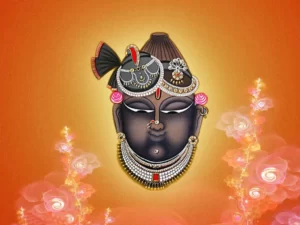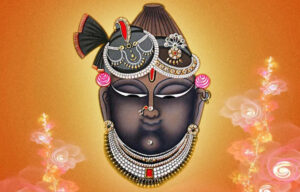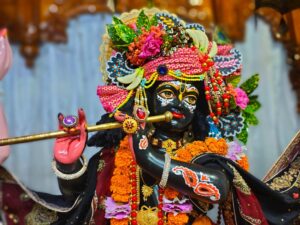The Legendary Ranchhodraiji
In the vibrant state of Gujarat, there stands a renowned pilgrimage site known as Dakor Dham, home to the famous Krishna temple dedicated to Sri Ranchhod Rai. While this may be a new discovery for those outside of Gujarat, it is a well-known and revered destination for the people of the state.
The name “Ranchhod Rai” is derived from the Sanskrit words “Ran,” meaning “battle,” and “Chhod,” meaning “to leave.” This intriguing moniker raises the question: How did Lord Krishna come to be known as Ranchhod Rai, and what is the story behind this epithet?

* Image source Wikipedia
The Legendary Battle and Retreat
The tale dates back to the Dvapara Yuga, when Lord Krishna, accompanied by Akrura, traveled from Vrindavan to Mathura. Upon arriving in Mathura, they confronted the tyrannical King Kamsa, whom Krishna defeated. After this victory, Krishna installed Ugrasena, Kamsa’s father, on the Mathura throne.
However, the two wives of Kamsa, who had become widows due to his death, returned to their father, Jarasandha, the powerful king of Magadha. Jarasandha, enraged by the death of his daughters’ husbands, vowed to destroy the entire Vrishni dynasty, to which Krishna and Balarama belonged.
Jarasandha, leading a massive army, repeatedly attacked Mathura, intent on eradicating Krishna and Balarama. Despite their valiant efforts, Krishna and Balarama were unable to defeat Jarasandha’s formidable forces. Faced with this relentless onslaught, Krishna and Balarama made a strategic decision to leave the battlefield and establish a new, secure city for the Mathura residents.
The Retreat and the Birth of Dvaraka
Recognizing the need for a safer haven, Krishna and Balarama led the Mathura residents to the coastal city of Dvaraka, which they built with their divine powers. There, Krishna welcomed the Mathura devotees and used his mystic abilities to transport them to the new city.
It was during this retreat from the battlefield that Krishna came to be known as “Ranchhod Rai,” meaning “the one who left the battlefield.” This epithet, which may have been initially perceived as a mark of dishonor, has since been celebrated and revered by Krishna’s devotees across India, particularly in Gujarat.
The Devotion of Vijayananada
In the town of Dakor, located a few hundred kilometers from Dvaraka, lived a devout Krishna devotee named Vijayananada. Every six months, Vijayananada would faithfully collect tulsi leaves and offer them to the Dvarakadhish, the presiding deity of Dvaraka.
Despite his limited means, Vijayananada found great joy in this simple act of devotion. He believed that even a small offering, if made with sincere devotion, is pleasing to the Lord. As the Bhagavad Gita states, “If one offers Me with love and devotion a leaf, a flower, fruit or water, I will accept it.”
The Miraculous Appearance of the Deity
As Vijayananada grew older, he would make the long journey to Dvaraka every six months to continue his tulsi offering. When he reached the age of 70, he expressed his concern to the Dvarakadhish that he might not be able to make the trip anymore due to his advancing age.
Hearing Vijayananada’s sincere plea, the Lord himself appeared in a vision and instructed him to go to a deep well in Dakor, where he would find the Dvarakadhish deity. True to the Lord’s words, Vijayananada discovered the deity in the well, and with the help of the local priests, he enshrined it in a temple, establishing the Ranchhod Rai temple in Dakor.
The Flourishing of Dakor Dham
Over time, the Ranchhod Rai temple in Dakor became a renowned pilgrimage site, attracting thousands of devotees from all over India. The town of Dakor itself transformed into a vibrant and picturesque tourist destination, known for its rich history and the beloved Ranchhod Rai deity.
In the 19th century, a wealthy businessman from Maharashtra, Shri Gopalrao Jamnadas Tambeker, had a divine vision in which Lord Krishna instructed him to build a grand temple in Dakor. Fulfilling the Lord’s command, Tambeker constructed the magnificent Hare Krishna Temple, also known as the Sri Radha Madhav Temple, which was completed in 2015.
The Legacy of Ranchhod Rai
Today, the Ranchhod Rai temple in Dakor Dham continues to be a beloved destination for thousands of devotees who come to seek the darshan (divine vision) of the Lord and partake in the special Ranchhod Rai laddus (sweets). The temple’s serene atmosphere and the captivating story of Ranchhod Rai’s retreat from the battlefield have made Dakor Dham a cherished pilgrimage site for both local and distant visitors.
The tale of Ranchhod Rai serves as a reminder that the Lord’s actions, though sometimes perceived as unconventional or even dishonorable by the world, are always guided by a higher purpose. It is a testament to the power of devotion and the Lord’s unwavering love for his devotees, who find solace and inspiration in the extraordinary story of Ranchhod Rai.



